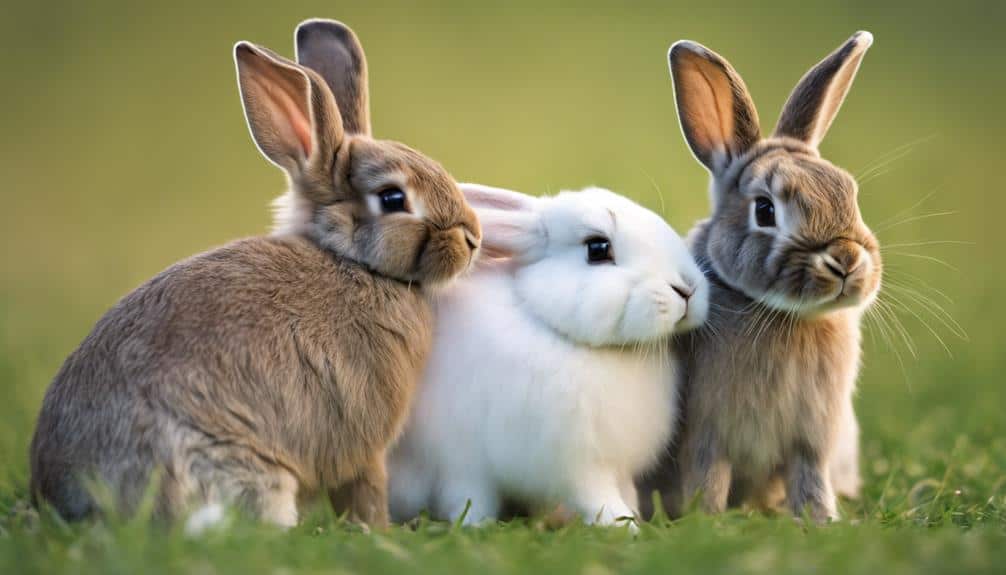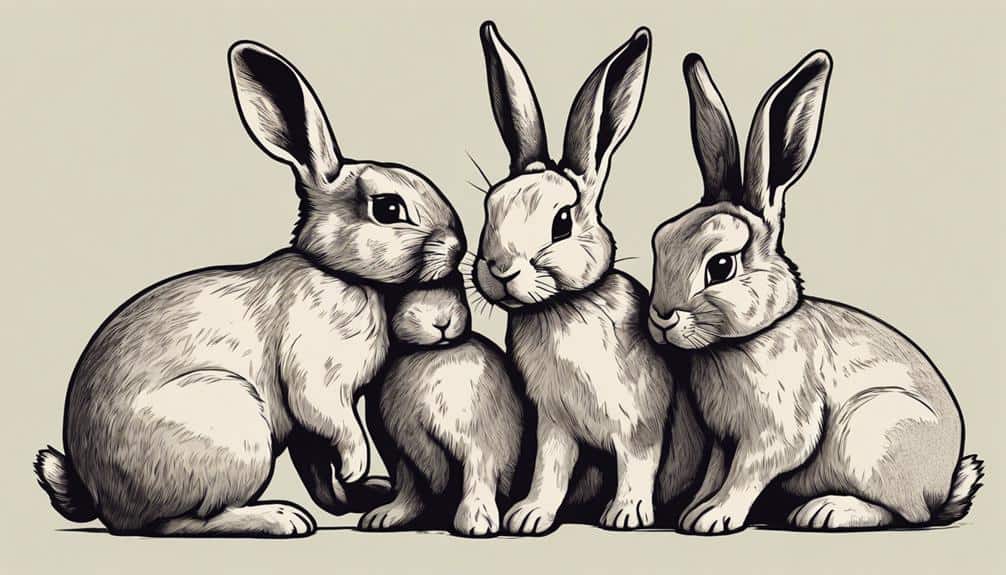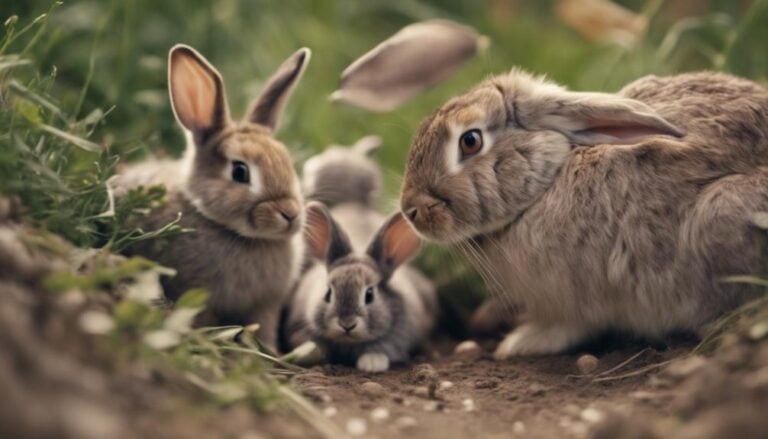Imagine orchestrating a delicate dance among three bunnies, each with its unique steps and rhythms. As you observe their interactions, you may wonder: Can these three bunnies truly bond?
The dynamics of multi-rabbit relationships can be complex, requiring patience, understanding, and strategic planning. Stay tuned to uncover the secrets behind successful bunny trios and the intricacies of fostering harmonious relationships in a multi-bunny household.
Contents
- 1 Key Takeaways
- 2 Factors Affecting Bunny Bonding Dynamics
- 3 Tips for Introducing Three Bunnies
- 4 Understanding Rabbit Social Behavior
- 5 Managing Mounting Behavior in Groups
- 6 Positive Signs of Bunny Bonding
- 7 Monitoring Long-Term Bunny Cohabitation
- 8 Time Frame for Successful Bunny Bonding
- 9 Frequently Asked Questions
- 10 Conclusion
Key Takeaways
- Neutering all three bunnies can minimize territorial behaviors and aggression.
- Understanding individual personalities, age, gender, and hierarchy dynamics is crucial.
- Providing a spacious environment with ample resources is essential for successful bonding.
- Monitoring for signs of stress, aggression, or behavioral changes is key to establishing harmony.
Factors Affecting Bunny Bonding Dynamics

Neutering all three bunnies is an important step to minimize territorial behaviors and aggression during the bonding process. Rabbits are social animals that adhere to hierarchy dynamics within a group. When attempting a trio bond, understanding the individual personalities of each rabbit is vital. Factors like age, gender, and hierarchy dynamics can greatly influence the bonding dynamics among the trio.
Creating a spacious environment with ample resources is essential to reduce potential conflicts within the bonded trio. This environment allows the rabbits to establish their territories and reduces the likelihood of aggressive behavior. Additionally, monitoring for signs of stress, aggression, and hierarchy establishment is key to a successful trio bond.
Tips for Introducing Three Bunnies
When introducing three bunnies, careful supervision and gradual introductions in a neutral territory are essential to prevent territorial disputes. Each rabbit's personality should be considered to guarantee compatibility and minimize the risk of aggression during bonding.
Initially, providing separate spaces for each bunny and then gradually increasing shared areas can help the trio adjust and form positive associations. It's important to monitor for signs of stress, aggression, or conflicts during the bonding process with three rabbits.
Having a structured plan for introductions, which includes activities like scent swapping and positive reinforcement, can greatly improve the chances of successful bonding among the three bunnies. By following these guidelines and being attentive to the bunnies' behaviors, you can create a harmonious environment for them to build strong relationships and thrive together.
Understanding Rabbit Social Behavior

Understanding the intricate social dynamics of rabbits can provide valuable insights into their behavior and interactions within a group setting. When three rabbits form a trio, they naturally establish a social structure through hierarchy. This hierarchy helps maintain order and minimize conflicts within the group. Grooming rituals are vital in reinforcing social bonds among the trio, as they signify trust and cooperation. By observing these rituals, you can gain a deeper understanding of the relationships between your rabbits.
Creating an environment that supports communal living is important for a trio of bonded bunnies. Providing sufficient space, hiding spots, and resources can help prevent territorial disputes and promote harmony among the rabbits. Respecting the natural social behaviors of rabbits and allowing them to interact and bond at their own pace is crucial. By recognizing and accommodating their social needs, you can foster strong connections within the trio, leading to a happy and well-adjusted rabbit community.
Managing Mounting Behavior in Groups
To manage mounting behavior in groups of rabbits, you must observe dominance displays closely.
Providing ample space and resources is essential to reduce instances of mounting among bonded bunnies.
Careful monitoring of their interactions can help prevent conflicts and establish a harmonious trio dynamic.
Addressing Dominance Displays
Addressing dominance displays, particularly managing mounting behavior in groups of rabbits, plays a significant role in maintaining harmony and stability during the bonding process.
When dealing with mounting behavior in a bonded trio of rabbits, consider these key points:
- Understanding Natural Behavior: Mounting behavior is a natural way for rabbits to establish hierarchy within the group.
- Monitor Carefully: Regularly monitoring interactions can help prevent any potential escalation of aggression.
- Not Always Aggressive: Remember that mounting can occur between rabbits of any gender and may not always signify aggression.
- Promoting Harmony: Addressing dominance displays proactively can contribute to a peaceful and harmonious environment within the group.
Providing Enough Space
Providing sufficient space for your trio of bonded bunnies is essential in managing mounting behavior and promoting a harmonious environment within the group. Bonded rabbits require ample neutral space to establish their hierarchy, reducing territorial disputes and potential conflicts.
Mounting behavior, a natural part of the bonding process, often signifies dominance within the group. Inadequate space can lead to an increase in mounting behavior and disrupt the bonding dynamic.
Monitoring Interactions Carefully
Careful monitoring of interactions among your group of rabbits is important for managing mounting behavior effectively and maintaining a peaceful social hierarchy.
- Observe Closely: Watch for mounting behavior during bonding sessions to understand the dynamics within the group.
- Create Neutral Spaces: Encourage interactions in a neutral area to reduce territorial behaviors that can lead to mounting.
- Track Interactions: Keep a record of mounting instances to identify patterns or triggers for aggressive behavior.
- Address Aggression Promptly: Intervene calmly but firmly if mounting escalates into aggressive behavior to maintain a harmonious environment for your rabbits.
Positive Signs of Bunny Bonding
When observing your trio of bunnies, pay attention to their body language cues, as these can indicate their level of bonding.
Mutual grooming behavior is a positive sign that they've established strong social connections.
Shared sleeping spaces demonstrate their comfort and trust within the group.
Body Language Cues
When observing a trio of bunnies bonding, positive body language cues such as mutual grooming, synchronized movements, and peaceful sharing of food indicate a strong connection between the animals.
Here are four key indicators of positive bunny bonding:
- Mutual Grooming: Witnessing bunnies clean each other's fur demonstrates trust and affection within the bonded trio.
- Synchronized Movements: When bunnies move in harmony, hopping or exploring together, it showcases a deep bond and shared connection.
- Relaxed Body Language: Bunnies with ears in a neutral position and a calm demeanor exhibit a sense of comfort and security in their group.
- Sharing a Sleeping Area: Resting or sleeping together signifies a profound level of trust and camaraderie among the trio.
Mutual Grooming Behavior
Observing bunnies engaging in mutual grooming behavior reveals a strong and positive bond between the trio, showcasing their trust and affection towards each other. Mutual grooming serves as a positive sign of bonding, indicating that the bunnies have established a level of trust and comfort within their group dynamic.
Through grooming each other, they establish a hierarchy, promoting a sense of belonging and reinforcing their social bond. This natural behavior not only demonstrates their harmonious relationship but also signifies that they feel safe and secure in each other's presence.
Successful bonding among the trio is evident when they engage in mutual grooming, as it solidifies their connection and reinforces the positive dynamics within the group.
Shared sleeping spaces among a trio of rabbits reflect a strong bond and a sense of security within the group. When bunnies choose to snuggle up close, it shows they trust and find comfort in each other.
Sleeping together not only helps regulate their body temperatures but also fosters a deep sense of companionship among the rabbits. Prior to settling down for the night, these furry companions may engage in grooming rituals, reinforcing their bond and establishing a harmonious social hierarchy.
Witnessing these rabbits peacefully sleeping side by side serves as a heartwarming indicator of successful bonding and the presence of harmonious relationships within the trio.
Monitoring Long-Term Bunny Cohabitation
To guarantee the successful long-term cohabitation of three bunnies, vigilantly monitor their interactions for any signs of stress, aggression, or behavioral changes. When introducing new rabbits to each other, it's important to create a neutral environment where they can get acquainted without feeling threatened.
Regularly monitor their interactions, paying close attention to any signs of stress such as excessive hiding, fur pulling, or teeth grinding. Aggression can manifest as chasing, biting, or mounting, so be proactive in addressing these behaviors to maintain a harmonious living arrangement.
If you notice any concerning behaviors, intervene promptly to prevent escalation and maintain the well-being of all bunnies involved. By providing adequate space, resources, and mental stimulation, you can help prevent conflicts in the long term.
Time Frame for Successful Bunny Bonding

During the bonding process of three bunnies, the time frame for successful bonding can vary greatly based on individual personalities and circumstances.
- It's important to understand that each bunny has unique traits that influence how quickly they form a bonded pair.
- Patience is key when allowing bunnies to establish their relationships naturally. Rushing the process can hinder successful bonding.
- Regular monitoring and supervision are essential to make sure the safety and well-being of the bunnies during the bonding period.
- Factors like age, gender, and past experiences play a significant role in determining the length of time it takes for bunnies to bond effectively.
Frequently Asked Questions
Do Rabbit Trios Work?
Rabbit trios work well due to the bonding process, social dynamics, territory sharing, group hierarchy, communication cues, behavioral interactions, and handling conflicts. Establishing a harmonious trio requires careful introduction, ample resources, and neutering all rabbits.
Can Rabbits Be Kept in Groups of 3?
Like a symphony harmonizing, rabbits in groups of 3 can thrive. Group dynamics establish a social hierarchy through grooming rituals. Adequate space, neutering, and careful bonding validate peaceful coexistence, minimizing conflicts. Monitor interactions for success.
Can Rabbits Be in Threes?
In a trio, social dynamics among rabbits involve territory sharing, hierarchy establishment, and communication cues. Bonding challenges may arise, requiring space, resources, and supervision. Behavioral observations help guarantee a harmonious relationship among the three bunnies.
Is It Better to Have 3 or 4 Rabbits?
When deciding between 3 or 4 rabbits, consider the social hierarchy and space requirements. A trio might offer a more balanced dynamic, reducing potential conflicts. Emphasize group bonding techniques, monitor behavioral challenges, and prioritize health considerations when introducing new rabbits.
Conclusion
As the trio of bunnies hop together in harmony, their bond becomes a tapestry of woven connections, each thread representing trust, companionship, and love.
Like a delicate dance of intertwined paws and twitching noses, their unity is a sign of the power of patience, understanding, and perseverance.
With time and dedication, three bunnies can indeed form a beautiful and enduring bond, creating a joyful tapestry of togetherness in the world of rabbits.






